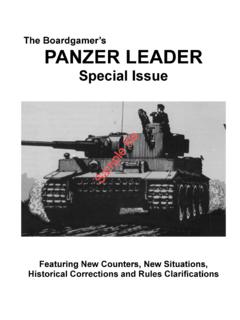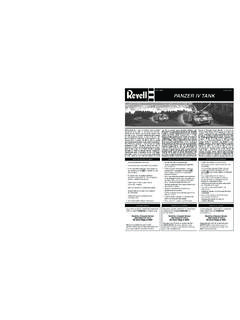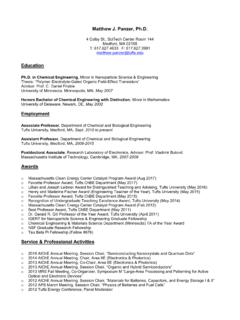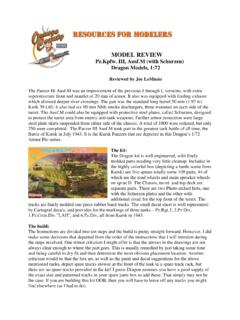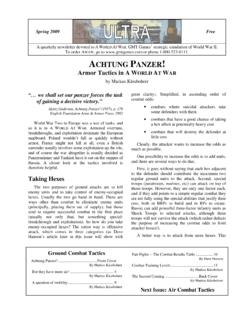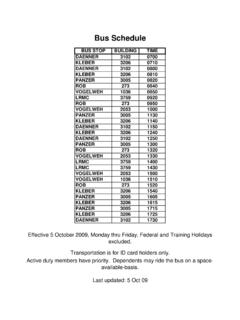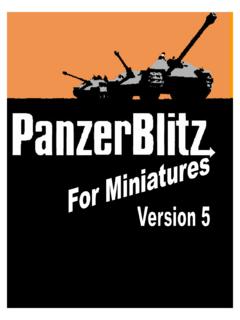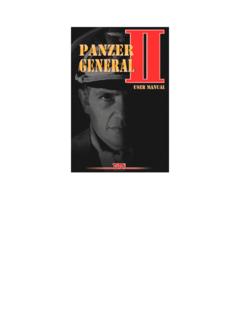Transcription of << Zheriz’s War Files >> Panzer Optics/Sight Guide
1 Document Author: Zheriz Zheriz s WW2OL Guide : Zeiss Sights Comments or Errors? Page 1 of 5 Document Version: May 20, 2005 << Zheriz s War Files >> Panzer Optics/Sight Guide Overview Zeiss sights are available in German tanks at the Gunner s position. Zeiss sights give the Panzer gunner an advantageous ability among WW2 tanks to determine the range to a target without the need to fire ranging shots. Used correctly, these sights give the Panzer gunner the following advantages: The ability to reliably hit a target with the first round ( first shot, first kill ). The ability to hold your fire to know if the target is inside your guns penetration envelope versus that targets armor thickness. ( Am I close enough to kill it? ) An ability to hit the target with fewer rounds, conserving ammo. A lower probability of detection, since the less you fire the less the chance you will be spotted by enemy units.
2 How it Works Zeiss sights work on the idea that if you have two objects of known size and one of those objects is at a known range, then you can deduce the range of the other object by doing a size comparison of the two objects. For example, you know that 2 boxes are each 2m wide. You know that Box A is 1000m away and appears to be 1cm wide at that range. Box B is at an unknown range, but appears to be 2cm wide. Since it appears twice as wide, you can deduce that it is closer and exactly 500m away. If it appeared to be wide, it would be twice as far, so at 2000m. And so on. A Zeiss sight works the same way, but instead of boxes it uses triangles of 2m size as they would appear positioned 1000m away from you. Apparently, this set-up was technically known as a Mili radian sight , which later became abbreviated to a mils sight . Mils becomes a short hand way for saying Document Author: Zheriz Zheriz s WW2OL Guide : Zeiss Sights Comments or Errors?
3 Page 2 of 5 Document Version: May 20, 2005 meters at 1000m range . Therefore, this 2m triangle at a range of 1000m is said to be 2-mils triangle. (See diagram). This is the trick that makes the Zeiss sight such a powerful advantage for Panzer gunners. By comparing the triangles against the known size of the enemy tank, a range can be determined. The Panzer Zeiss Sight This system is extrapolated to a more advanced form as seen in the Panzer Zeiss sights. The Zeiss sight uses seven triangles: six small and one large. This is necessary so that the target object size can be measured and computed at all ranges instead of only 1000m. On the right is the deceptively simple Zeiss sight without the range arcs. I didn t include the range arcs ( circles ) in this tutorial because they re after the fact. You dial the range arc based on the range the Zeiss sight gives you and not vice versa.
4 The range arc settings in the Keymapper are PgUp and PgDown. The range arc sometimes has 2 arcs. The inner arc is always for AP rounds and the outer arc is for HE rounds. What does the sight mean? Okay, this diagram can be confusing so take your time and notice all the details. It is critical that you understand the dimensions of this sight because you will measure your target dimensions against it. First, notice that the aim point is at the top tip of the 4-mil triangle and NOT at the center of the triangle as most players believe. That aim point is where the gun round is calibrated to hit. Document Author: Zheriz Zheriz s WW2OL Guide : Zeiss Sights Comments or Errors? Page 3 of 5 Document Version: May 20, 2005 Second, notice that the large 4-mils triangle has twice the dimensions of a 2-mils triangle this fact comes handy later. The top of it is the same size as the other small triangles (I put in a dashed line so you can see it easily).
5 Third, notice that the space between ALL the triangles is 2-mils at the bottom and 4-mils at the top. It s 4-mils at the top because, as indicated, half of each triangle is 1-mils, so from tip to tip it s: 1-mils + 2-mils + 1-mils = 4-mils. You have to train yourself mentally to interpret the bottom and top gaps as 2-mils and 4-mils. The mind has a tendency to count only the triangles and to ignore the spaces. The large triangle also makes you think the spaces around it are larger but in truth the spaces around it are the same as those around the small triangles. Ziess Sight Limitations Overall, the Zeiss sight is excellent but has some limitations: For targets from 0 1200m the sight is excellent for ranging. From 1200 2000+m it is less effective since the target can become very small and hard to compare. Low contrast situations (fog, night time lighting, camouflage and obstructed views from vegetation) can make seeing the edges of the target difficult, which can make a size comparison inaccurate.
6 Brightly colored tanks will seem closer than they are, while darker colored tanks will appear farther away, so trust the Zeiss sight instead. Moving targets can make a comparison difficult. Combat Use #1: Ranging an ET To use the Zeiss sight in combat can be either hard or easy. The hard way is to measure the target size and compare it against the known size of the target and mentally (or by calculator) do the math to finally determine the range. This is a lousy way to do it and for some reason all of the scarce few Zeiss guides available use this method. Frankly, it s a slow and tedious way to do it. Do you really want to do math under fire? I didn t think so. Or you can do it the way WW2 tankers did using Range Tables, which I have provided below. It works like this: Document Author: Zheriz Zheriz s WW2OL Guide : Zeiss Sights Comments or Errors? Page 4 of 5 Document Version: May 20, 2005 1) Measure the size of your target in Mils using the triangles 2) Get your range value from the handy printed Range Tables.
7 3) Dial your range, set the aim point on the hull or turret and fire! If you leave the aim point in the measuring position (see diagram) you re round will probably hit the dirt just short of the treads. The only catch is that you have to compare the correct dimension. If you measure the length of the target, then you have to use the length column values. If you measure width, you have to use the width column values. It s pretty simple. Width is the head on view. Length is the side view. Usually, you will either get a length or width measurement since the target is either side ways (length) or facing you head on (width), respectively. What is height for? The height measurement is used for diagonal measurements. If the target is facing you at a diagonal, you cannot measure either the width or length since the perspective is skewed. So you have two options: 1) you wait for the target to face you the right way or 2) you measure the height and get your range that way.
8 Either way is fine, but sometimes waiting is not an option so just measure the height. Example Here an A-13 Cruiser is facing length wise and it has a Mils size of 8. In the range tables for A-13 under length , we get a range of 753m. You can measure the target using the tops or bottoms of the triangles. You don t have to use the center of the sight either; you can measure from the ends too. Just as long as you can count the Mils size, it doesn t matter how it s done. TIP: the 4-mil triangle has a handy use. If you think about it, it s the same 2m triangles; only it s set at 500m instead of 1000m. Since most tanks are about 2m tall, any tank that fits the 4-mil triangle top to bottom is roughly 500m away a handy way to get a quick estimate. Document Author: Zheriz Zheriz s WW2OL Guide : Zeiss Sights Comments or Errors? Page 5 of 5 Document Version: May 20, 2005 Combat Use #2: Ranging terrain This is a good Zeiss trick for pre ranging terrain.
9 With 1 shot you can get a range to any point. This is great for ambushes and static defense. Let s say you know that enemy tanks will be coming over that hill over there and you want to range the hill. This is what you do. 1) Place the aim point on the area you want to range and dial in an estimated range. Fire one shot and observe the impact point. 2) Move the turret so that the Zeiss aim point overlays the impact point (don t touch the range dial) 3) Now without moving the turret, dial up the range arc until the aim point moves up (or down) to match the area you really wanted to hit in the first place. Bingo! You have ranged that area. Final words The best part is, if you know the size of anything, you can use the Zeiss sight. For example, the white roads are 8m wide, while the red roads are 4m wide. An AB wall is about high. An infantry unit is tall. Any of these values can be used to give you a range using the Zeiss sight.
10 The general formula is: (Known size x 1000) Mils size = range The Zeiss sight can be a great advantage, but it requires practice. Trying to use the Zeiss sight while someone is firing at you can be nerve wracking, but with practice you can do it in a split second and kill the ET with one shot while he s still trying to range you with a hail of fire. So be patient and practice, it does pay off. So go forth and strike fear into Allied tankers! =) Final final Words: this Guide is not as developed as I d like. I wanted to add more visual examples and detail, but it will have to wait for a future update to this file. A car hit my puppy recently (it survived with surgery) and caring for it is time and so on. milslengthwidthheightmilslengthwidthheig htmilslengthwidthheight14,6202,2602,3601 3,9901,8802,10014,2201,9502,15022,3101,1 301,18021,9959401,05022,1109751,07531,54 075378731,33062770031,40765071741,155565 590499847052541,055488538592445247257983 7642058443904306770377393666531335067033 2535876603233377570269300760327930785782 8329584992352638528244269951325126294432 0923394692172391046222623610399188210104 22195215123851233312352143301428514301mi lslengthwidthheightmilslengthwidthheight milslengthwidthheight15,3002,1002,62016, 3002,4802,74015,0302,5202,57022,6501,050 1,31023,1501,2401,37022,5151,2601,28531, 76770087332,10082791331,67784085741,3255 2565541,57562068541,25863064351,06042052 451,26049654851,006504514688335043761.
